Mark L. Van Name's Blog, page 173
April 26, 2013
Rembrandt's house
Today's featured attraction was the Rembrandt House Museum, the building in which he lived from 1639 to 1658. From what I've read there and elsewhere, Rembrandt was as good with money as many other artists and writers: he paid an outrageous sum for a house he really couldn't afford, ultimately failed to pay off his mortgage, and after almost twenty years in it, he went bankrupt. His creditors did what those sorts of folks always do: sold the house and auctioned his possessions.
The lesson for us all is simple: no matter how great an artist or writer or whatever else you may be, if you get in trouble financially, your creditors will ultimately catch up to you.
On the way to the house, I saw in rapid succession two signs whose juxtaposition amused me. The first was this crossing sign on a perfectly lovely but deserted street.
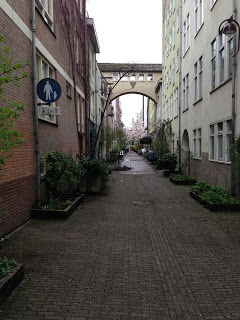 Click on any image to see a larger version.
Click on any image to see a larger version.The second appeared in a restaurant.
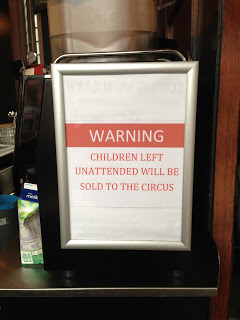
I love when life presents these little moments of contrast.
The house was quite interesting. Its exhibits made tangible the reality of the artist's life. The people who built the museum were able to reconstruct the house so accurately because when the creditors took it back, they systematically inventoried every item in every room, by room, often noting where objects were in the room. Add information from Rembrandt's own drawings, and you have enough data to do a pretty good job on the place.
It opened with this exhibit of items that renovators found in 1997 in a cess pit and then dated from the time Rembrandt lived here.
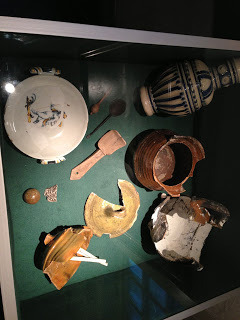
One of the earthenware pots contained lots of lead white, and the other held chalk and glue. Things broke, he threw them out. Perfectly natural and in no way a surprise, but still neat to see in person.
The large kitchen featured a tall fireplace on one side and a prep counter on the other.
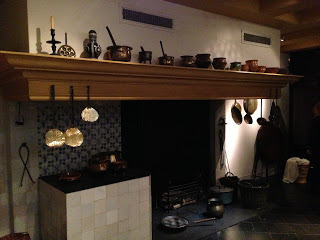
On the wall with the door was a large cabinet that housed, among other things, the maid's box bed.
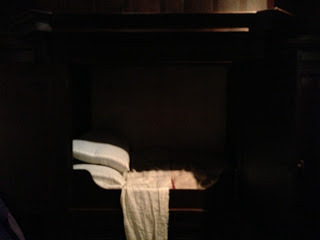
As you may be able to tell, it was small, so I have to hope she was, too. It was also probably the best bed in the house for much of the year, because the fireplace, which they kept burning all the time, would have made it the warmest place to sleep.
The entrance hall was basically a gallery, where Rembrandt sold his work and that of other artists as well.
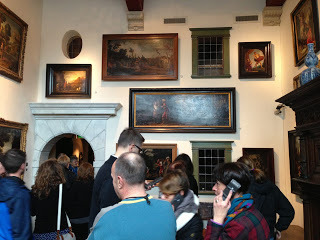
Hey, while you're waiting, want to buy anything?
He was always hustling, something else that hasn't changed for modern artists. Guests would move from this waiting room into Rembrandt's anteroom, where he would entertain them and, he hoped, sell them something. It also contained more paintings for sale, as well as a guest box bed (he slept upstairs, though maybe he also rested here).

I wish I could show you shots without other visitors in them, but the place was crowded the whole time I was there. I also apologize to all the folks whose images I'm putting here, though I don't think these pictures will invade their privacy much, if at all, because I have no clue who any of them are.
Another way in which Rembrandt was very much like most artists and writers I've known is that he kept art all around him. His living room/bedroom was full of paintings.
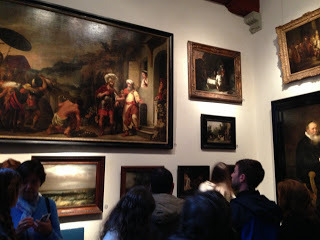
He and his wife, Saskia, slept in an almost double-bed-sized box bed along the wall with the door.

Rembrandt didn't just live and paint in this house; he also worked on his etchings and printed them, here. In a room off the anteroom, he had a press, a drying line, and a workbench.

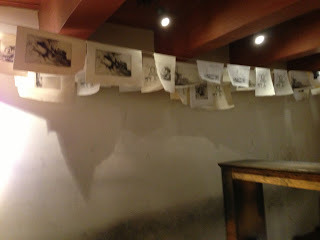
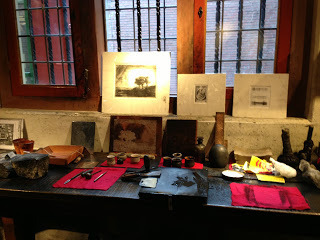
The soul of the building, though, was on its top floor: the studio where he painted. With windows covering most of one wall, he had great northern light for most of the day.
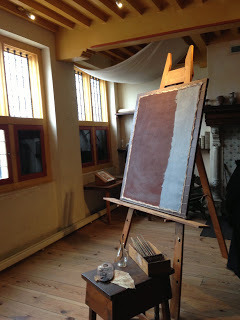
On shelves around the room he kept some reference materials, but most of it was open space for posing models and painting.
The most fascinating room was what the exhibit signs called his "Art Cabinet," but which we could also term his reference library or even his own personal kunstkammer. He kept not only his art books here--volumes with at one point over 8,000 drawings and prints by many artists--but also a huge collection of oddities, items he found inspirational or useful in his work.
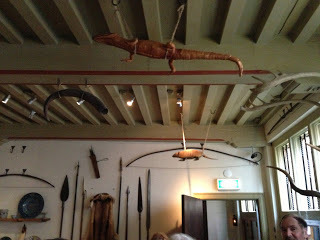

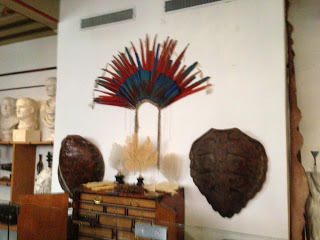


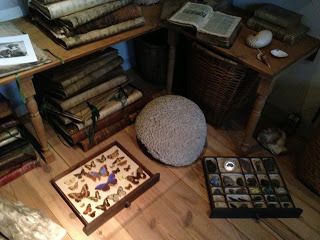
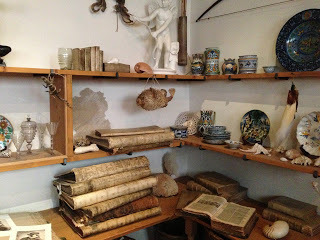
In addition to brain coral, lizards, armor, and many other items, the room held not one but two stuffed armadillos. I'd love to do an anthology based around the items in this room; it would be fascinating--and sell about six copies.
The museum also features an extensive collection of Rembrandt's prints, along with several of the original plates. You can find the prints in plenty of books, so I won't spend much time on them here. I did, though, find fascinating a few of the presentations, such as this version of Jesus on the cross
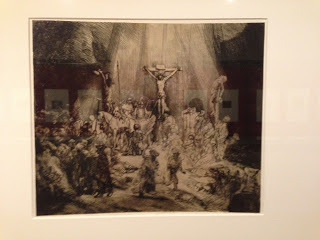
and this one, which Rembrandt made years later by revisiting the same plate and reworking it extensively.
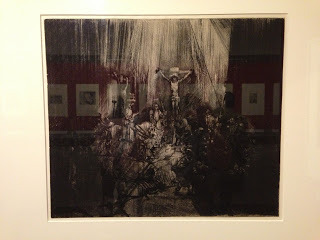
Getting to see both the etching and the original plate was also a treat, as in this duo about Potiphar's wife, who failed at seducing Joseph but kept his coat for later blackmail use.
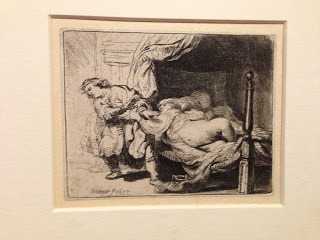
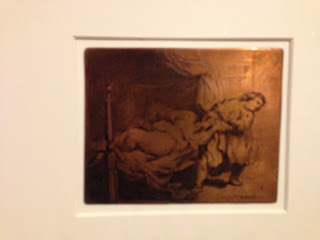
I could go on and on, but it's late here, so I'm stopping and encouraging you to check out Rembrandt's prints if you are not already familiar with them.
Out on the streets, a wandering path took me by the lovely Old Church, among many other places.
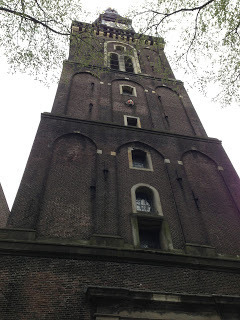
Ducks and swans make homes and nests on bits of wood tied to the sides of the canals.
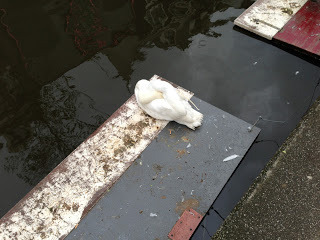
One bit of sad news is that in preparation for reopening the Van Gogh museum on May 1, when I will already be back in Paris, about a week ago they started moving the collection out of the Hermitage. So, though I will get to see the Hermitage, I will not make my second visit to the Van Gogh museum this trip. This results from my lack of planning and research, so I accept it as one of the downsides of an approach I have generally enjoyed. Still, I wish I'd been able to catch that collection.
Tomorrow, more art!
Published on April 26, 2013 20:59
April 25, 2013
Hitting the streets
If the weather forecasts are reliable, today is going to be the nicest day of my stay in Amsterdam, so I decided to spend the day walking the streets and getting a sense of the city. I wandered all over the place, including through the famous "Nine streets" boutique shopping area.
This city loves its hot dogs. Stands selling them are everywhere. On the canal bridge nearest the hotel, two vendors sit opposite one another in fierce competition.
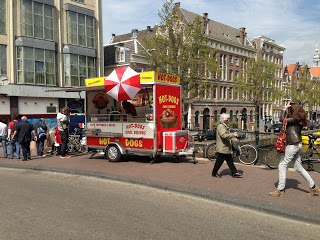 Click on any image to see a larger version.
Click on any image to see a larger version.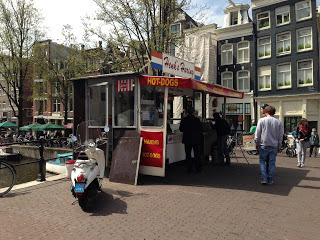
Fries are also big here. People walk the street eating them from cones. Toppings range from ketchup to mustard to curry to combinations better left unwritten. This chain seemed particularly popular; I encountered three of them during my walk.
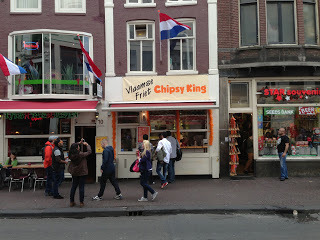
Bicycles are everywhere, as are cars. Traffic is intense, with bicycles, cars, trams, buses, scooters, and pedestrians all vying for space and the right to move forward. Here some parked bikes give you a sense of just how many are in use.
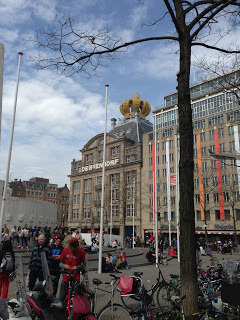
The crown on the building in the above shot is due to Tuesday being Queen's Day, a national holiday celebrating the Queen--and a particularly important one this year, because the next day the Queen will step down in favor of her son, who will become the King.
The combination of so many hot dog stands, fry vendors all over the place, and intense traffic made me realize that I arrived at this city unprepared. What I really needed is my motorized
If only I'd thought of that earlier. Ah, well.
Back in the real world, this statue, the National Monument, sits in Dam Square as a tribute to those who died in World War II and subsequent armed conflicts.
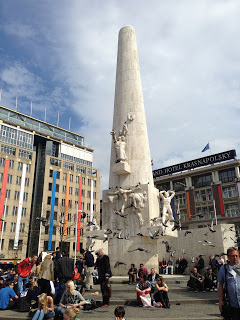
Across the square from it sits the Royal Palace, a lovely building.
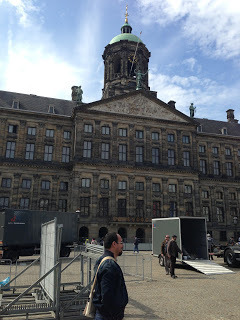
On another side of the square is the Nieuwe Kerk (New Church), which like the palace was getting decked out for the upcoming holiday.

Parking on the canal is common here, so having a small car certainly makes sense. Some cars, though, are just too damn small. Cases in point:

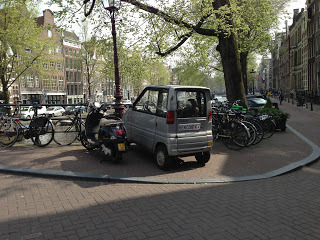
Graffiti doesn't run rampant here, but some appears in interesting places. I liked this one.
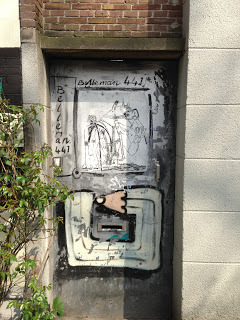
Hey, Sarah and Ben, a camera store focused heavily on lomography.
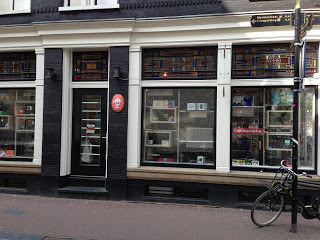
And, Ben, a shop that sold primarily bow-ties.

Note the cat sleeping in the window. Ya gotta love shop cats.
I loved the mellow attitude the owner put above this door.
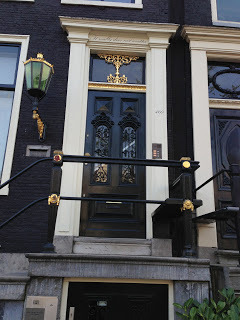
Or maybe it was an existentially correct attitude, such as Dave's. No way to know for sure, though in a city with marijuana bars--blasts of smoke hit you as you walk down the street, I'm betting on mellow.
The day was indeed perfect for wandering, the sky lovely and clear, the temperature in the high 60s.
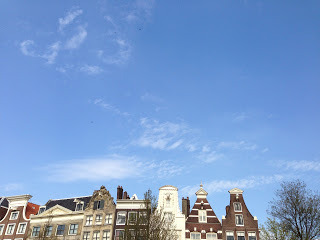
Glorious.
Did I mention hot dogs? I had no clue you could buy them 33 to the can.
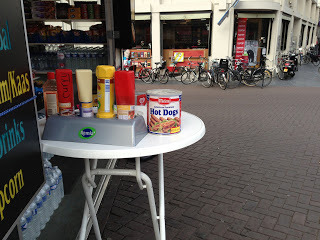 An automat!
An automat!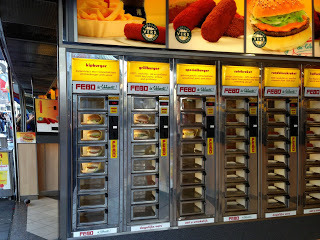
This theater was lovely.
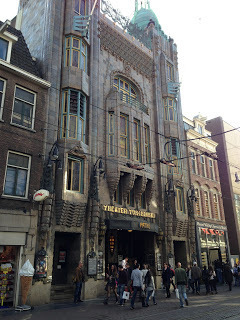
Dinner was at an Indian restaurant that proved to be a very good choice. The food was quite tasty, and I encountered something delicious I've never seen before: cheese naan. The server said it wasn't really Indian food but that "you can get it everywhere."
Well, I can't, and now I want to know why. Cheese naan is awesome!
Tomorrow, forecasts call for rain, and I have no clue yet what I will do. That's just the way I like it.
Published on April 25, 2013 20:59
April 24, 2013
Travelin' man
This morning went to sleep and reading and being lazy, and a big chunk of the afternoon to travel to a new city, so I don't have much for you.
Lunch was a sandwich in the park on a bench in the shade. The cherry trees remain gorgeous. When the wind blew, the blossoms whirled like loose snow, and small children ran to play in the petal blizzard. Everyone in the area stopped and smiled.
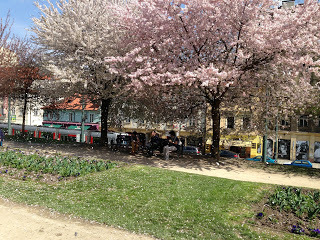 Click on any image to see a larger version.
Click on any image to see a larger version. 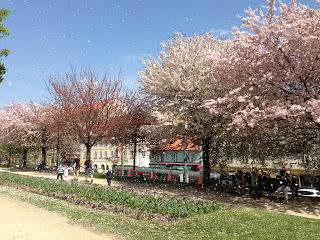
The blossoms pooled on the ground like pink and white jewels.
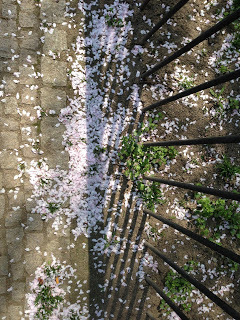
I flew Czech Airlines today for the first time. Boarding was an unorganized scrum, but otherwise the flight was uneventful and pleasant, all that one can ask from a flight in economy.
Now, I'm in a new city. Clues?
It is, to me, a logical progression of the art tour I've been informally doing. Got it?
Not yet? Okay, the streets are cosmopolitan and full of all manner of shops and food.
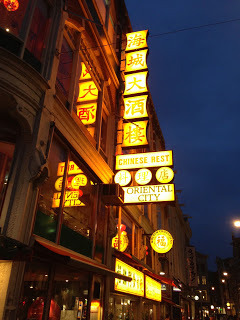
Not yet? Does this help?
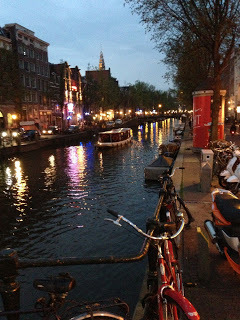
If you don't already have it, I'm in Amsterdam, home of the newly reopened and supposedly amazing Rijksmuseum (Allyn, thanks for pointing out to me the renovation and reopening), the Rembrandt House Museum, the Van Gogh Museum (closed now for renovation but with its collection fortunately on display in the Hermitage), and many more.
I look forward to wandering the streets and to barraging my brain with great art!
Published on April 24, 2013 20:59
April 23, 2013
The shortest Eiffel Tower
Though I've made it a practice this trip to walk everywhere I reasonably could, I could not resist the chance to ride a funicular up a hill to a cluster of buildings, a park, and Petrin Lookout Tower. The view from inside the funicular was just what you'd expect, but I still enjoyed the ride.
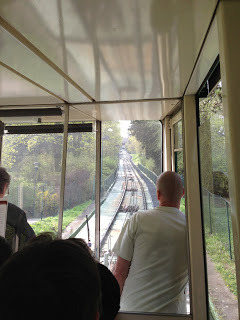 Click on any image to see a larger version.
Click on any image to see a larger version.Petrin Tower was just one of many interesting buildings on this hilltop, but it was the one that motivated the trip.
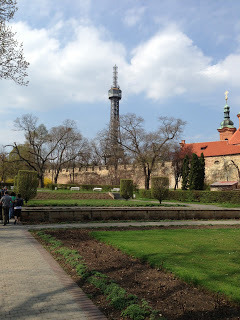
Viewed from this distance, you can tell it's shorter than the Eiffel Tower, which it was built to resemble. It is not an exact copy, and it is much shorter than the original, but by sitting on this hill its top is actually at a higher altitude than the original's peak.
On the way to it, I ran across another children's park that contained a lot of structures and devices on which I would have loved to play, though I can't imagine any of them passing safety muster in the U.S.

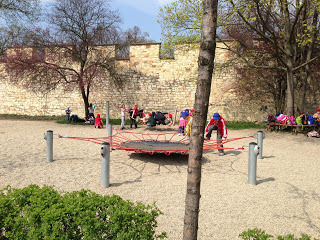
The kids sure seemed to be enjoying them.
Up close, Petrin Tower does a decent job of imitating the Eiffel.
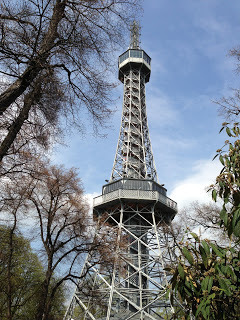
On paths around it are twenty religious constructs like this one.
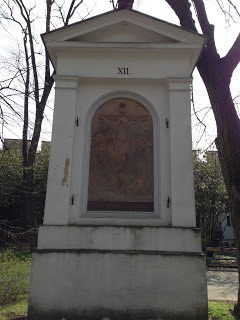
I don't know what they all represent, but many of them were quite lovely.
The view from atop Petrin Tower is remarkable. I could see parts of the city that hadn't been clearly visible from any other vantage until now. In the distance in this shot is what looks like a completely different, modern city of nearly interchangeable high-rises.
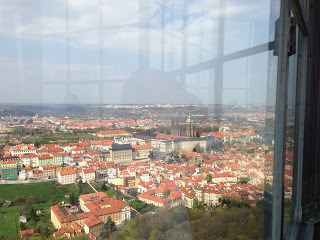
In this picture, a group of buildings shares a parking lot with the name (upside down here) "Silicon Hill." I assume it's some sort of high-tech area, which is great to see here.
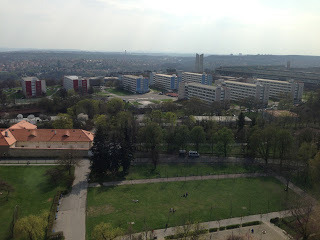
Back on the ground, this nearby odd little chapel was chained shut and unlabeled. For no particular reason, I rather liked it. From the rear, it's intriguing.
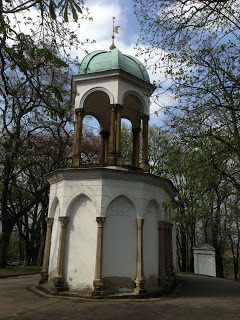
From the front, it's clear no one has done much with it recently.
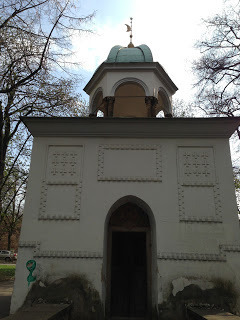
The grandest church on the hill, St. Michael's, was different from most of the others I've visited in the city.
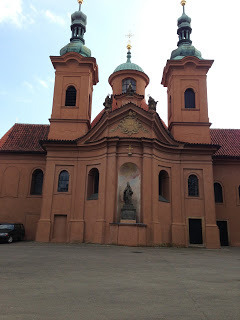
No internal tour was available.
This little chapel, which sat next to it, was more interesting for the work carved into its facade.
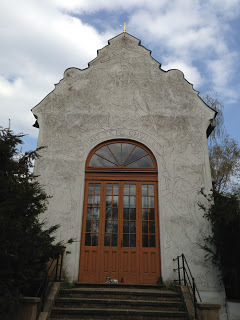
On another side of the small square that three buildings shared was a building called the Mirror Maze. Along with the maze and a room full of fun-house mirrors, the structure housed a diorama, built originally for the 1891 Jubilee Exhibition in Prague, entitled "Battle with the Swedes on the Charles Bridge."
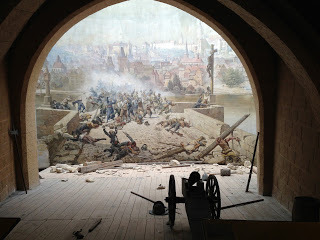
Czech history has been neither a particular passion of mine nor a topic I knew much about, so I was intrigued to learn a bit about this 1648 battle.
A sign advertised a "Magic Grotto," but after following the path to it, I found it deserted.
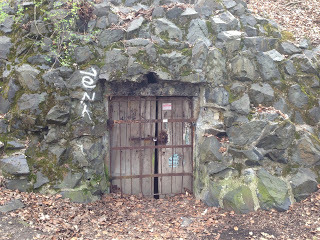
Too bad. I'm always up for a magic grotto.
A nearby building claimed to house some of the magic grotto's stuff, but it didn't appear to be open for business. It did, though, have these awesome gargoyle planters.
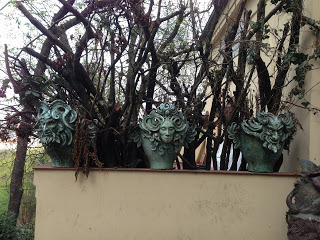
Back down at ground level, I sat for a time on a bench under a beautiful cherry tree and enjoyed the perfect spring day.

Late tomorrow afternoon, I head to a new city!
Published on April 23, 2013 20:59
April 22, 2013
Meanwhile, back at the castle
Armed with a ticket for the works, I spent all of today's tourist time at Prague Castle. First stop was a return visit to St. Vitus' Cathedral, but this time my ticket let me explore all of it that is open to the public.
The stained-glass windows are generally nice, though not my favorites.
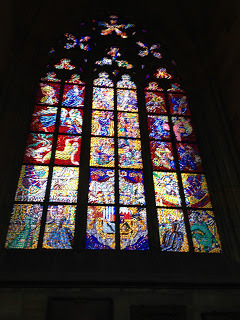 Click on any image to see a larger version.
Click on any image to see a larger version.The one Mucha designed, however, is absolutely gorgeous.
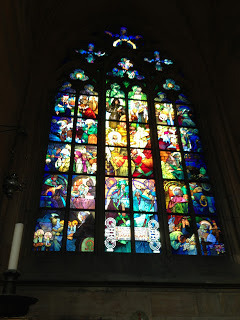
Paintings, frescoes, and tapestries adorned the many small chapels inside the church, but none were labeled. Some looked like relatively new additions, while others, such as this one, felt quite old and were often in a bit of disrepair.
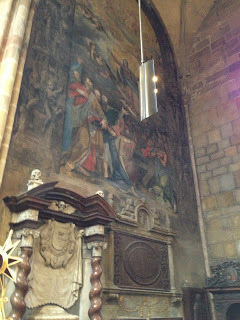
Everywhere you go here, you get the sense of a land that has spent much of the last many centuries under various kinds of renovation, some by choice, others by necessity. Without actually getting to know any Czechs, I've come to admire the resilience of these people.
St. Vitus' houses many tombs, all decorated but some far more ornate more than others.
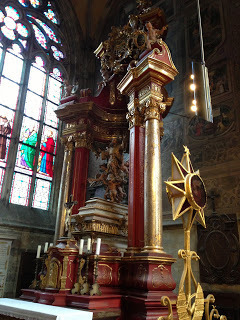
This one, which was nearest the front of the church, was clearly of great importance--and so big I couldn't get it all in one shot. (It proved to be the tomb of St. John of Nepomuk; the tomb alone contains two tons of baroque silver.) Just this much, though, should give you a sense of how ornate it was.
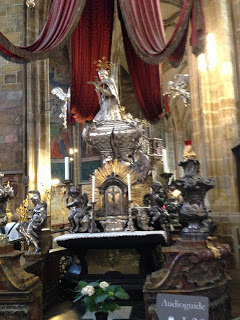
The most completely decorated room in the place was cordoned off, so I had to settle for an exterior shot. I have no clue what made it special, but I would like to have been able to study it further.
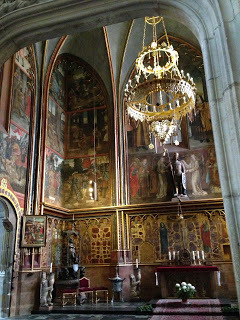
Did I mention the organ?
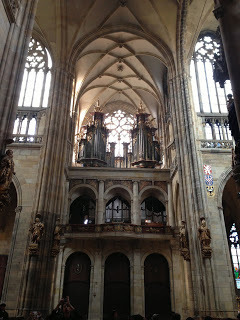
I was interested and pleased to see this memorial book for lost Czech airmen.
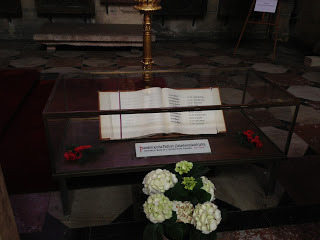
I also quite liked this mosaic.
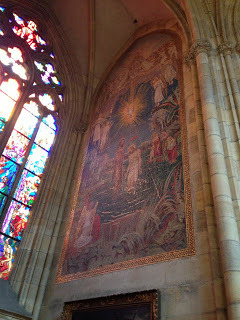
Wandering through the gift shop, which I routinely do though I've yet to buy anything in one, I couldn't help but notice the copyright on this bit of Kafka merch.

Ah, you have to love unintentional humor.
Another key stop today was the Picture Gallery. Centuries ago, it housed the collection of Rudolph II and was one of the world's great art assemblages. Various wars and conquerors subsequently left it empty. What's there today has all arrived in the last hundred years or so. The result is that it contains some interesting works but is just not up to the level of the many galleries I've seen on this trip.
I did like this piece by Bartholomeus Spranger.
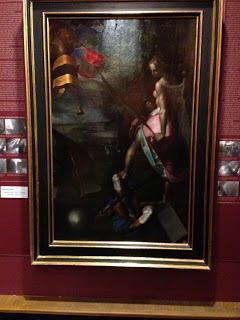
Guards were everywhere, and the place does not allow photography, so I didn't take many pictures. Still, I couldn't resist this nifty teaching tool for the above painting.
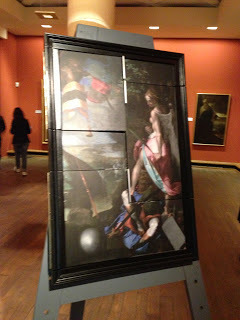
Lift any of the pieces with handles, and text inside points out the symbols and other interesting facts about that section of the work.
I would love to get Google to pay me to create a team to do this with Google Glass for all of the great works of art of the world. Forget audio guides; imagine augmented reality with visual and auditory input under your control. It would be awesome.
An unusual work was this illusionist triple portrait of Rudolph by Paulus Roy.
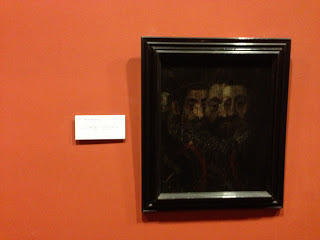
From the little I've read on this subject, it appears that Rudolph enjoyed this sort of thing.
The collection did include some work by major artists, including this Holbein.
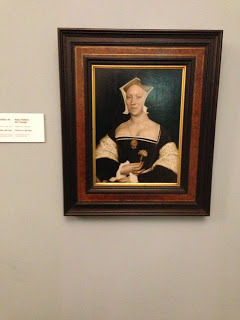
Most of those pieces, though, were either obviously minor or the work of the artist and his studio, with the studio's contributions frequently obvious and not up to the work of the master involved.
I had not before noticed any work by Lucio Massari, but this one was lovely and very well done.
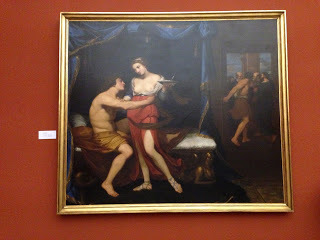
This Veronese also stood out and was an exception to my above observation about the bigger names in the gallery.

I was not previously familiar with the paintings of Pauwels Franck, better known as Paolo Fiammingo, but the odd imagery in this one--note the frog man with hat in the lower left corner--really struck me.
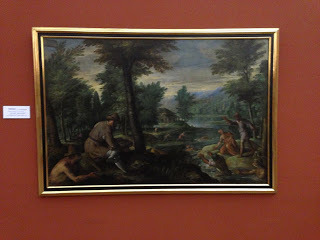
I'll be on the lookout for more of the work of this man who studied under Tintoretto but who clearly pursued his own vision.
The Treasury of St. Vitus is small and forbids photographs, but it is well worth a stop. Its intriguing sets of reliquaries and moniles (reliquary pendants that church officials wore) were worth the cost of admission. This reliquary of the arm of St. George is cool indeed.
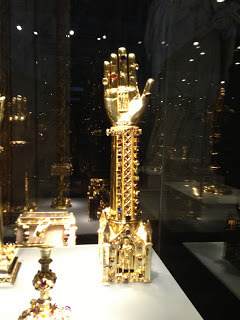
The creators of this reliquary had so many bits and pieces of St. Martin that they built an entire panel of them!
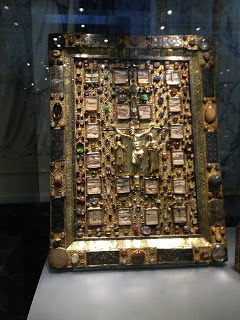
On the way to a quick tour of the small history of the palace honor guard (okay but not particularly noteworthy), I passed this odd structure.
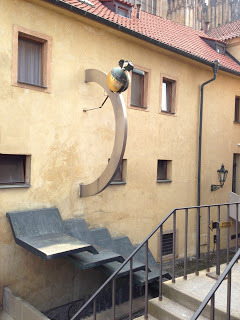
No sign explains it, and no one seemed to notice it. I liked it.
St. Vitus' from the back.
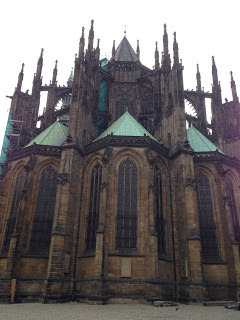
The Basilica of St. George, the oldest church on the property, from the front.
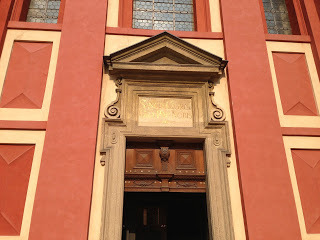
This church started in the 900s and has been through many iterations since then. The building is in rough shape but is nonetheless fun to visit. Some very old frescoes remain and are of interest.
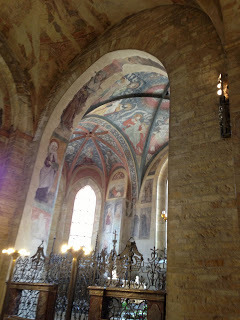
An armory exhibit nearby mostly showcased one suit of armor after another, but its real tourist attraction was this room full of torture devices.
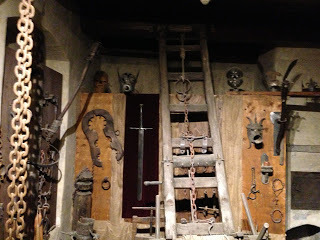
Though they were clearly crammed into one space to appeal to tourists, the presence of the devices makes sense given that a prison stands adjacent to the armory.
At this end of the castle, another path leads down to the city, so of course I had to take it. Wandering vaguely toward the hotel, the path passed by an opening to the Vojan Gardens. Though there was only one way in and out, and thunderclouds were gathering overhead, I had to check it out; you can't ignore a garden you encounter by happenstance.
I'm very glad I did. It was lovely, with a small pond, people resting on the ground and on benches, and many beautiful trees, including this magnolia.
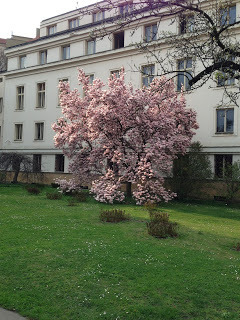
An added treat was the surprise appearance by this peahen
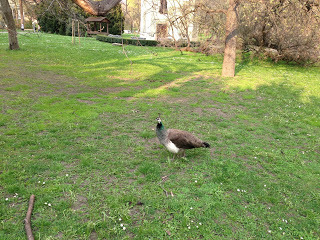
and this peacock, who chose to pose between two dumpsters for my camera.
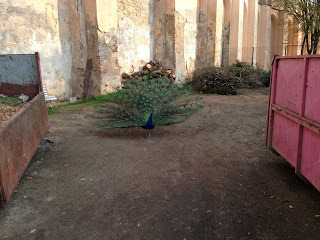
I have no clue if this bookstore is related to the one in Paris, but seeing it made me smile.
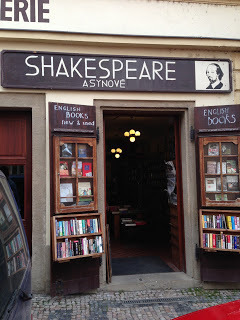
Tomorrow is likely to take me on an unusual ride. Stay tuned!
Published on April 22, 2013 20:59
April 21, 2013
Mucha, spring, and walking
Today was too beautiful to make it an entirely lazy day, though I did sleep and read and generally laze about until the middle of the afternoon. Walking is a key part of this trip, though, so I hit the streets with an eye toward visiting Old Town again and taking in the small but interesting Mucha Museum.
I crossed a different bridge into town and was treated to a group of tourist boats waiting for a lock.
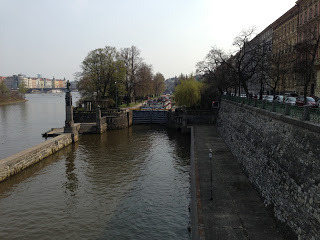 Click on any image to see a larger version.
Click on any image to see a larger version. The lock is only on the canal the tourist boat uses, and it wasn't visible from the Charles bridge, so it was neat to get a chance to see it.
An island in the middle of the river was under construction, the builders off today but clearly working on restoring a structure that a sign identified as a castle but that looked to me like just another large, plain building.
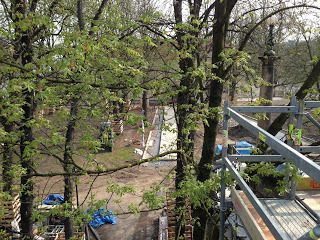
On this part of the river, a few folks in paddleboats were enjoying the beautiful spring day.
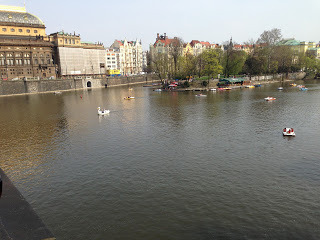
I don't know what this building is, but it was so very different from everything around it that I had to take a shot of it.
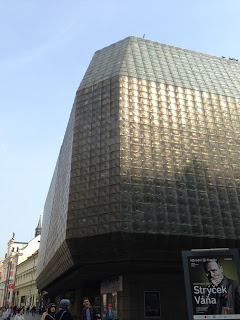
Who wouldn't like an eye turned blue with yarn?

The sign is in front of a theater.
This nearby building's Art Nouveau decorations seemed in keeping with the museum visit.
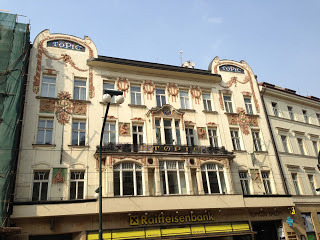
I thought a lot about the sentiment of this sign, which a man was painting as I walked by it the first time.
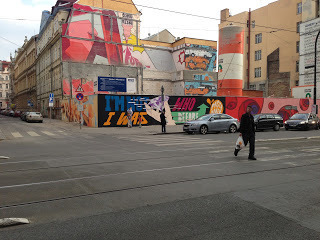
I wondered if this trip would leave me different than who I was before. In the end, I concluded that, no, not really, it would not, but with luck it would help focus me and make me a better version of myself. Time will tell, as it does with all such things.
In multiple places in Prague and in Vienna, I've encountered signs for black light theaters. Though I strongly doubt I'll visit one, I find the notion odd enough to be intriguing. This one, paired with the KFC banner in front of it, cracked me up.
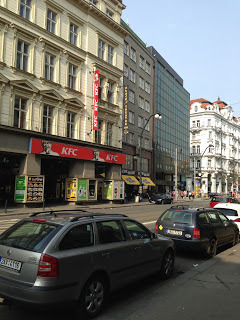
Thirsty? I was, so I grabbed a bottle of Czech-labeled Coke Zero.
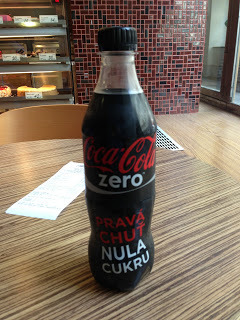
I must confess that I have made zero progress in learning Czech, nor do I expect to before I leave.
As I noted earlier, the Mucha Museum was quite small, but I nonetheless learned many new and interesting things about the artist. The place forbid photography, so I took very few shots. I did particularly like the large versions of this foursome, The Arts, because in them he chose to eschew all traditional symbols for the arts in favor of using times of day and motion to symbolize them.
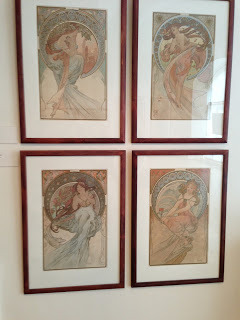
Getting to see a few of his original paintings was a treat. These two, very different in mood, particularly caught my fancy.
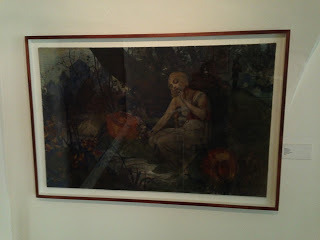
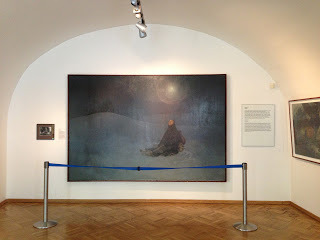
A series of portraits in his studio showed off both the widely varied contents of his workplace and his occasionally whimsical side, the latter best seen in this picture of Paul Gauguin at the harmonium.

His Paris sketchbooks were also interesting. I was surprised at the wide variation in finish of the drawings in them.
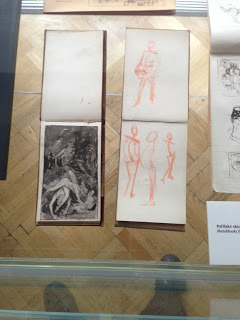
Outside, while taking a randomly different route back to the bridge, I was happy to see this bit of (admittedly not very good) art stuck to the side of an otherwise unremarkable building.

Back on the hotel's side of the river, the statues of dissidents tortured by the Soviets were a moving contrast to the lovely cherry trees facing them.
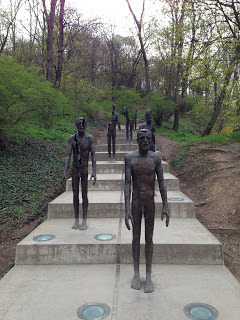
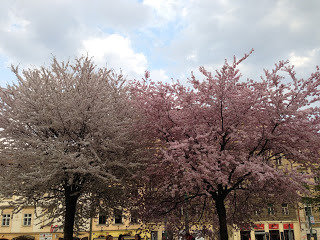
Enough people have bugged me in email for a photo with me in it that I am relenting with this one.
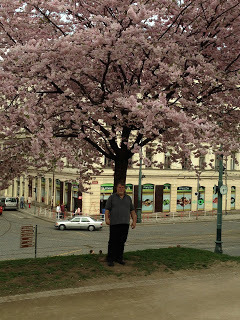
Why the park includes this snake sculpture is beyond me, but I kinda liked it.
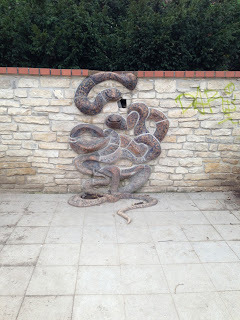
I definitely would have liked this play structure (you have to blow up the picture to get any sense of it) when I was a kid, though I can't imagine the U.S. allowing such a thing in an open public park; too much risk.
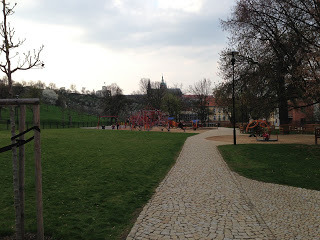
Still, I sure would have played on it.
Published on April 21, 2013 20:59
April 20, 2013
Churches and a castle
Though a light drizzle was falling, I decided today was not going to be the lazy day. Maybe tomorrow, depending on the weather and how I feel. I'll figure it out then.
Today instead turned into reconnoiter-Prague-Castle day. The castle is fairly close to the hotel as the crow flies, but the crow doesn't have to walk up the hill. Cabs can take you there, but that wouldn't be in the walking spirit of this trip, so with a pause for a quick lunch, in the early afternoon I walked the streets and switchback to the castle.
Along the way, I finally found myself at the front door of the church in some of my first Prague photos. It proved to be the St. Nicholas Church, a baroque wonder. The first version of the church came online in the late thirteenth century. In the middle of the eighteenth century, a rebuilding project incorporated a Roman rotunda from the nearby church of St. Wenceslas.
The combination of the baroque architecture and the rotunda is quite stunning.
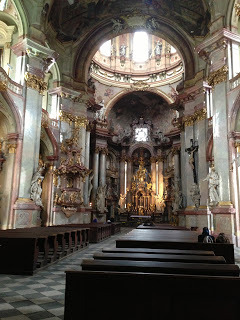 Click on any image to see a larger version.
Click on any image to see a larger version.Every aspect of this place was highly decorated, frequently with images of saints and bishops and other clergy or people of significance; I could not identify them all. The ceiling was simpler than Italian church ceilings but still cool.

The side chapels were consistently lovely as well, as you can see in this shot that includes two
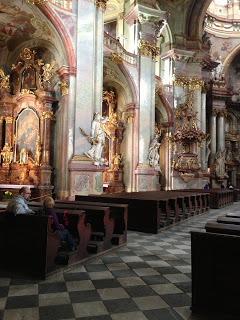
and in this image of one of them.

I particularly liked the tombs under a few of the side chapel altars, such as this one.
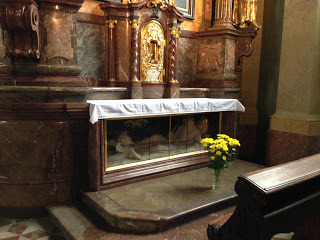
The rear of the church wasn't too shabby.

Nor was this pulpit.
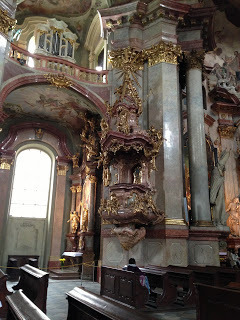
Maybe Bill and I need a pair of these for PT company meetings.
Nah, probably not.
The main altar was heavy on St. Nick and lighter on Jesus than I had expected.
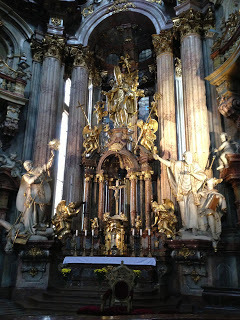
As I walked around and examined the paintings and statues, once again the new-old nature of Prague became very clear. Most of items were more recent than a quick glance might suggest, no doubt due to rebuilding after damage from time and/or wars.
Prague is a city always reinventing itself, in dialog with itself, melding the fading and sometimes destroyed past with the present to create a new, always changing version of itself.
In this church, if you climbed a winding staircase to the gallery, you could see the ten original old paintings that it still contains. Signs dated all of them from 1672 to 1674, but nothing said who painted them. I found them generally good but no more. Most moving, to me, was this Pieta.
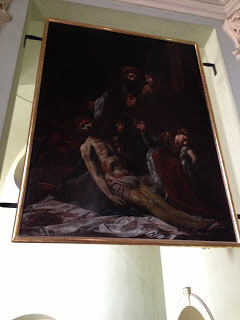
On the way up to the castle, I got a good, close look at some roofs for the first time. It was interesting to see that whether the tiles were flat or curved varied, at least in this area, from house to house, not neighborhood to neighborhood, as I'd thought I'd previously observed in other areas.
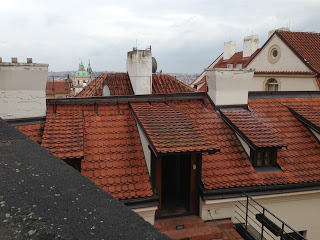
The views from beside the castle were spectacular. As a young American woman leading some friends up the street said, "And here's where it gets breathtaking."
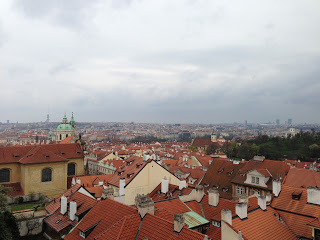
People were everywhere, enjoying the day despite the occasional drizzle and the cold, staring at the castle, walking, talking, playing, laughing, thinking, in groups and alone, all united by the desire to see this set of national treasures. A cellist (far away in this photo) filled the square with lovely music.
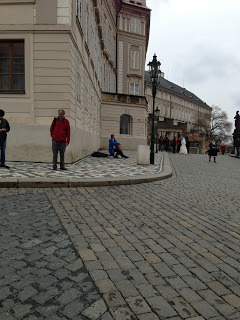
As if they were alone in the world, a man petted and stroked a dog who had eyes only for him, and then stopped, straightened, and stared into the distance as if a ghost had called his name, the dog waiting patiently beside him.
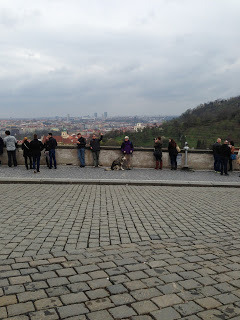
Inside the castle grounds, the gothic St. Vitus' Cathedral towered over everything.
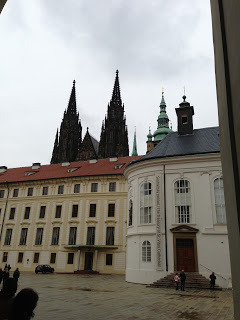
Up close, it was more impressive and more lovely.
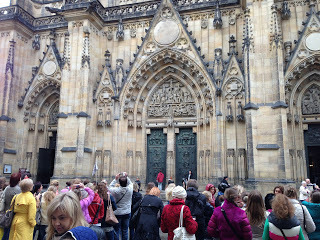
Today was reconnoitering day, so I did not buy any castle tickets. That meant I could enter St. Vitus but had to stay in a small area. I'll go back, probably on Monday, but even this glimpse inside made clear that this was a serious gothic church.
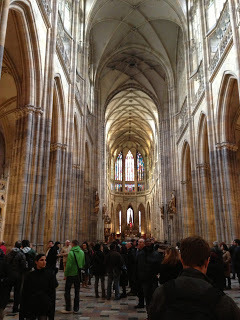
I assume I'll have more for you then on this lovely old building.
Outside, I wandered over a bridge across a deer moat.
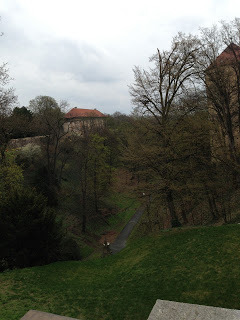
I have a freakish inability to remember plant names, but I still sometimes enjoy strolling through gardens, so I wandered the castle gardens today.
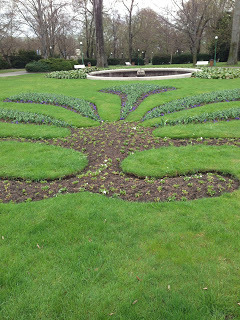
They were not ornate, but they were well tended and lovely--and they had signs identifying quite a few of the trees, which I very much appreciated. I was particularly interested in this dawn redwood, a tree, the sign explained, that was once thought to be extinct until discovered in Sichuan in 1941. An American expedition in 1949 gathered seeds there and distributed them to many leading botanical gardens. This tree is from one of those seeds.
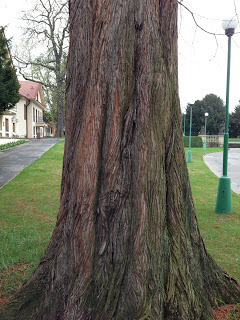
The walk uphill brought me in on one side of the grounds, so I naturally descended via the stairs on the other side. Here's the view uphill at about a third of the way down.
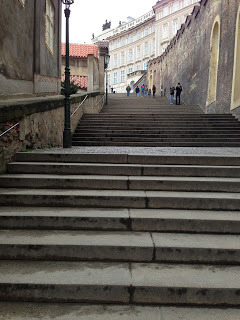
The view in the other direction.

Taking a different path back to the hotel, I couldn't resist stopping by the John Lennon Wall, which is on a wall of the Anglo-American University.
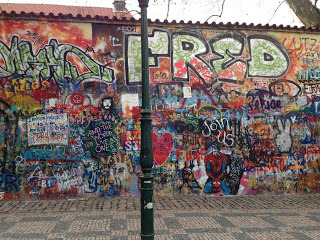
As you can tell, many of the contributions have nothing to do with Lennon, and from the way some of my fellow visitors were talking, not all of them knew or cared much about him.
Some, though, did, and I did, and that was more than enough for me.

The Lennon contribution in the middle of the above photo is clear. To the left of it, midway down the picture, are these lines:
THE UNDERTOW'S A BLESSINGI don't know who wrote that, or even if someone wrote it for this wall, but I like it.
AND OUR BRUISES BLOOM LIKE WORKS OF ART
This image with lyrics from "Because" also was lovely, particularly from a bit of a distance.
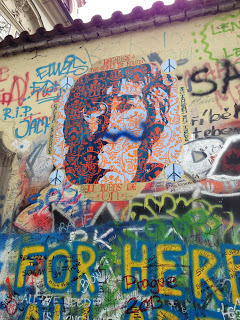
On an entirely mundane note, Prague stores offer Lays chips with grilled bacon!
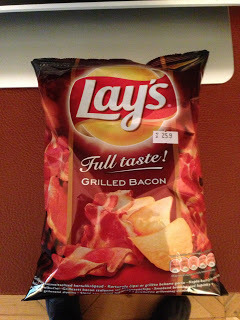
They were, predictably, yummy.
Published on April 20, 2013 20:59
April 19, 2013
Wandering
Each city I've visited is clearly European, a place you'd never expect to encounter in the U.S. Each is also, however, distinctly different, with its own architecture, culture, and feel. In both Vienna and Prague, places I've never been before, wandering the streets has helped me get a sense of the cities. Doing so is particularly difficult here in Prague, where I cannot read anything not written in English; in Vienna, I could at least stumble through some bits of the German.
Prague is a very new old city in that it is an ancient town that has been heavily rebuilt since the tremendous damage it sustained in World War II. So, most buildings feel old, and in some ways they are, but they also frequently have many new aspects.
Certainly, lovely churches are everywhere (though I've gone inside only one of them; more on it below).
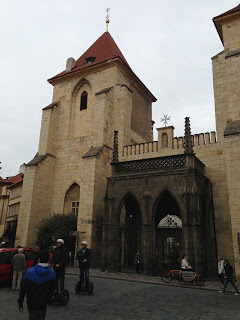 Click on any image to see a larger version.
Click on any image to see a larger version.I don't know the name of this one; I just liked it and took a photo as I walked by.
Prague is the historical capital of Bohemia, so I suppose this name is reasonable. It still made me smile.
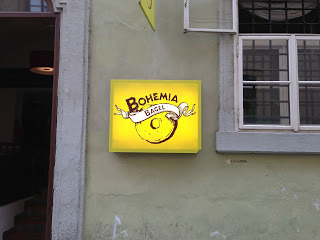
The main bridge across the Vltava river (aka the Moldau) is the Karluv, or Charles bridge. Wide and jammed with tourists at seemingly all times, it is still an impressive span that features a great many interesting statues, such as this one.
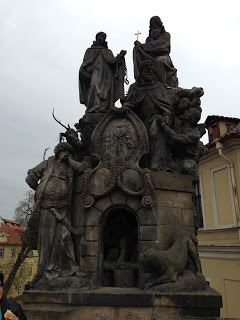
All of them are replicas, with the originals in the National Museum, but they were still intriguing and occasionally moving.
A few boats full of tourists chugged along the otherwise pleasantly empty river.
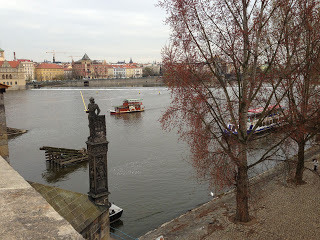
A band was playing when I crossed into Old Town, working the crowd for a living from tips and the odd CD sale.
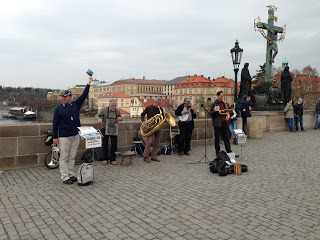
They were still playing hours later when I headed back to the hotel.
Towers stand over each of the bridge's ends. Here's the one on the Old Town side.
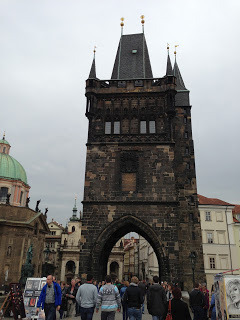
The inside top of this tower's arch is lovely, if in need of restoration.
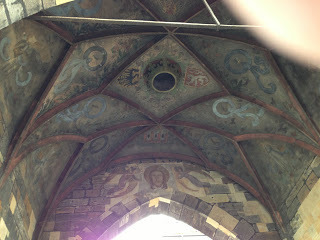
Why a straw chicken at the base of a church?
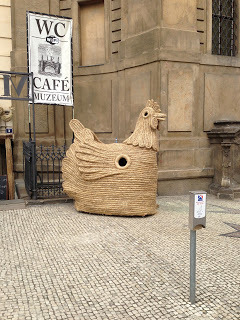
It seems to have something to do with Easter, though I can't guarantee that. The lack of words I can read here definitely leaves me sometimes without the data I'd like and frequently prompts bits of research.
Though I know nothing as important as freedom is ever simple, I couldn't help but like these signs.
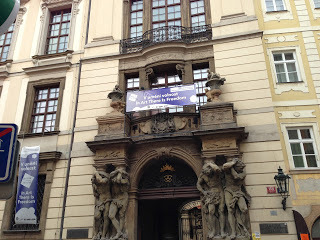
The Prague Astronomical Clock is a perfect example of my sense of the city: lovely, esoteric, difficult to understand, and ancient (the initial installation was in the early 1400s).

The clock is also relatively new, necessarily rebuilt after German attacks in World War II basically destroyed it--but rebuilt to look old and to retain as much of its original sense as the builders could manage.
From the top of its tower, the views of the city were excellent.
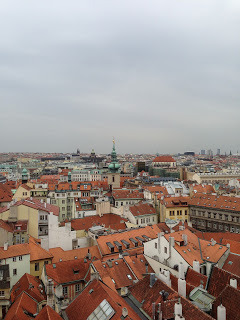
On the hour, the clock puts on a show, with revolving figures and ringing bells. The clock itself is better than the show, though the show is fun.
Ah, street vendors roasting hams on an open fire. I'm going to like any city square with that going on.
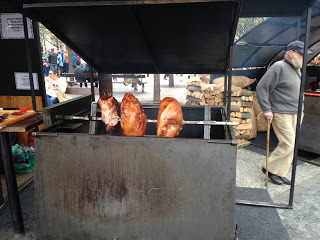
I found this Art Nouveau touch on this corner building quite lovely.
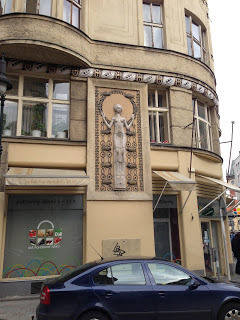
The one church I visited today was the Staronova Synagogue, also known as the Old New Synagogue. This gothic building, on which the original construction finished in 1270, is one of Europe's two oldest active synagogues.
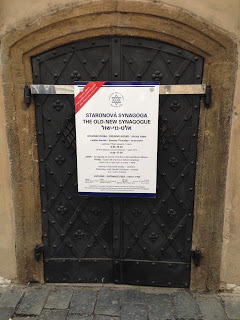
It's a relatively plain building, powerful inside in spite of, or maybe because of, the minimal decorations. I complied with the rules and took no photographs, in part because of the feel of the place and in part, to be honest, because of the constant presence of old women patrolling it and watching all visitors for signs of bad behavior.
Back on the streets, it was impossible to avoid noticing that, like the beach, Prague has the squeeze!
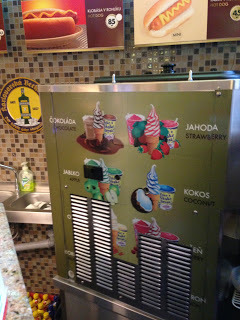
Yes, I treated myself to a small cup of red-streaked, kinda-sorta-cherry squeeze.
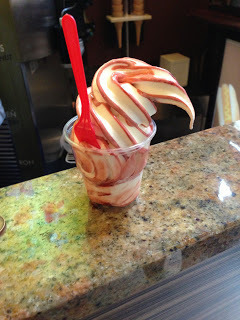
Prague is also obviously a very cosmopolitan city. For example, if you feel like having fish eat the dead skin off your feet, you can do it here.
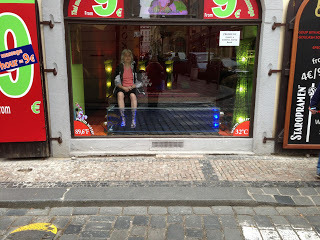
No, that's not for me. Not ever.
It may rain here all day tomorrow, in which case I might just stay in and read and write and chill. Or not. That's one of the beautiful things about this trip; I don't have to decide right now what I'm going to do tomorrow.
Published on April 19, 2013 20:59
April 18, 2013
Spring and moving on
Spring is in full bloom in Vienna, and the city is beautiful. Today was new-city day, but before heading out, a walk in the nearby city park (the Stadtpark) provided a great way to enjoy the season.
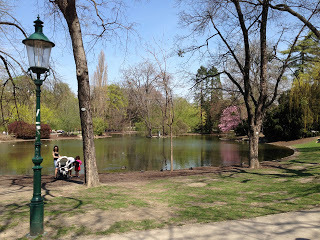 Click on an image to see a larger version.
Click on an image to see a larger version.The river separating the two halves of the park appeared shallow but lovely.
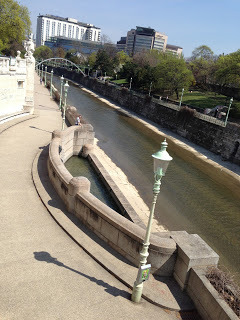
A tiny waterfall provided the sound of running water, which I always love.
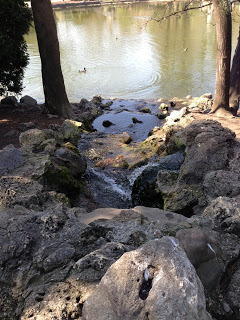
Why a fountain with spitting penguins? I have no clue, but I liked it.
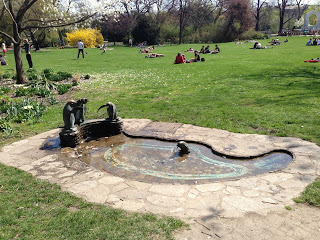
Later, at the train station, I was tickled to spot the "Wiesel" trains, complete with namesake images on them.
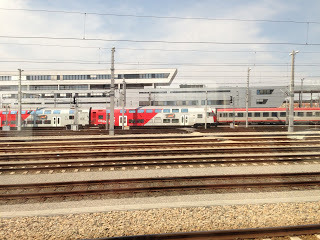
The countryside during the ride in Austria was uniformly lovely.
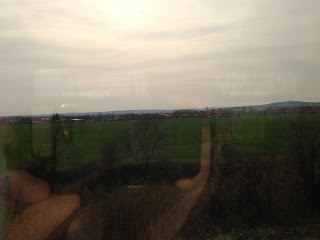
Sorry about the reflection.
As to where I was heading then, and where I am now, well, here are two clues.
It's a natural place to follow the art, and I've never been here before.
Not enough?
Okay, try this image of a traditional restaurant, which the concierge at the fabulous hotel recommended.
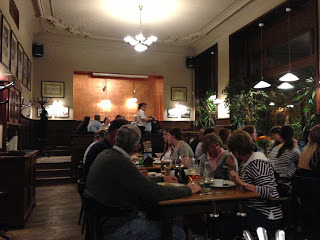
Got it? If not, does this help? The Caesar salad, which two of us were splitting, came with bacon and chicken--without the menu mentioning either one.
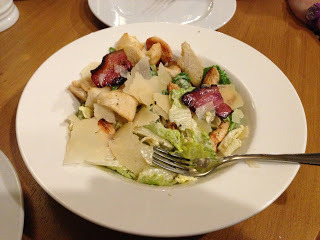
Still not enough? Does this outdoor shot help?
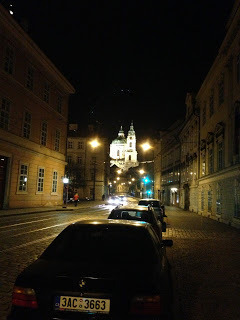
For those who've guessed, yes, I'm in Prague.
Now, back to that restaurant. The menu featured a mixed grill for two with potatoes and vegetables. The price was very low, so I figured it couldn't be too large. I haven't eaten much meat in quite some time, so we went for it.
That, of course, was before I had seen the huge Caesar salad.
This is what arrived at the table.
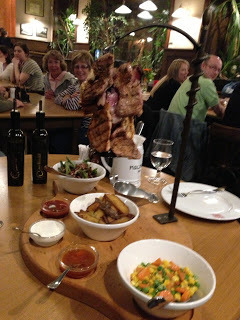
Yes, it was a special wooden plate with a giant mound of meat hanging from a curved metal pole. What could be better?
I'm glad I asked.
The server, a surly twenty-something woman who clearly didn't want to be there, pulled out a metal sauce boat and a lighter. She lit the liquid in the bowl on fire, and then poured it on the meat!
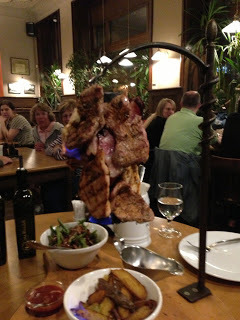
Oh, yeah, that's what's better than a special wooden plate with a giant mound of meat hanging from a curved metal pole: a special wooden plate with a giant mound of flaming meat hanging from a curved metal pole!
Even better, the drippings fell onto the potatoes.
Kyle, I wish you could have been there.
No, we didn't finish it. I did, though, greatly enjoy it even though I kept my portion size under control.
On the walk back to the hotel, I stopped in a grocery store for some Coke Zero and still water. The store was full of young people almost dancing in the aisles to some electronic music, and it had Vittel, my favorite water.
I am already loving Prague!
Published on April 18, 2013 20:59
April 17, 2013
Italians and Spanish and cake
Though you can't tell it from this blog, most days on this trip I eat healthier and less than when I'm at home. Sometimes, though, a great restaurant or a street vendor makes a bit of bad eating simply irresistible. So it was today, on the way to the Kunsthistorische Museum to see its collection of Italian and Spanish works, when the wurst stand beckoned me with its promise of the wurst box.
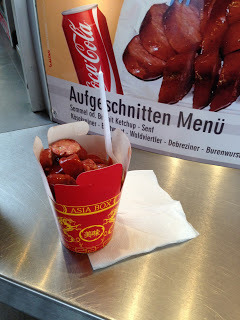 Click on any image to see a larger version.
Click on any image to see a larger version.We're talking wurst with cheese, on top of French fries, covered in more-or-less ketchup, in a Chinese take-out box.
No, I didn't even come close to finishing it.
Back at the museum, but this time in its Italian wing, another man was painting a reproduction.
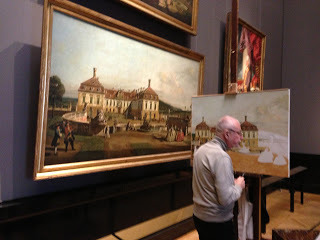
Sorry for the hazy shot; it's hard to get good pictures surreptitiously. I don't know why, but seeing a person doing that makes me happy.
I know very little about Francesco Furini, but after seeing his work today, I want to know more. This piece was particularly lovely.
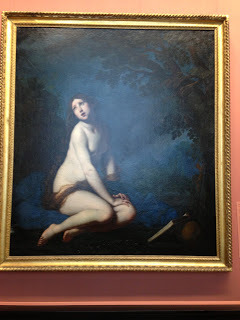
Similarly, the Spanish painter Antonio de Pereda was new to me but really engaged me with this symbol-laden piece.

The collection was reasonably varied, with far more Italian works than Spanish. Had I never visited the museums in Florence or Venice, this would have struck me as an amazing set of paintings. It is amazing, but obviously not up to the sets of Italian paintings in those cities.
Diego Velazquez had few works on display, but those available were beautiful. I particularly liked this one, which was one of the last two pieces he completed before his death.
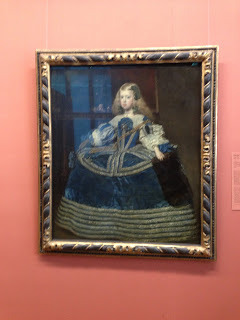
Again, never let anyone tell you your best work is behind you.
The photo I took cannot capture the beauty of this Bronzino, and the glare is terrible, but the picture is still, I think, worth sharing.
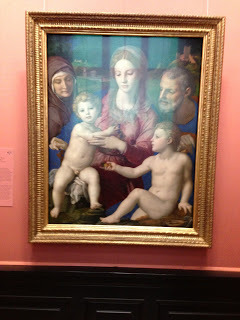
By the way, don't get spoiled by all these pictures; the great bandwidth at this hotel is what makes it reasonable for me to share them. When the bandwidth quality declines, so, too, will the picture count.
The greatest revelations for me today came from the work of Giuseppe Arcimboldo, a sixteenth-century painter I am amazed and embarrassed I had not encountered before. This guy's best work, his "portraits" of seasons and elements, was whacked in absolutely wonderful ways.
Here's his Summer.
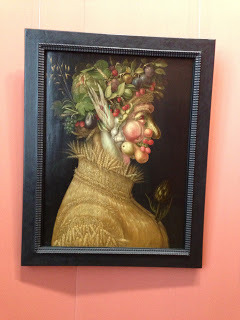
Yes, he makes heads of an amazing variety of things. I particularly loved Water.
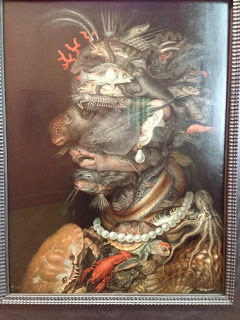
To return to a more traditional master, the collection had a nice sampling of paintings by Raphael, such as this Madonna.
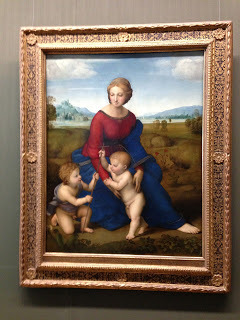
Yes, I really broke the no-photography rule today. People were doing it everywhere, the guards didn't seem to care, and I wasn't using a flash, so I went a bit crazy.
Also on display were quite a few works by Tintoretto. Most featured his usual dark backgrounds, but I absolutely fell for this completely atypical, lighter piece.
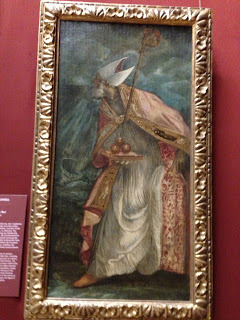
The collection also included a few paintings by Veronese and Titian, whose works I always enjoy seeing.
In another part of the giant complex that was once the home of the Habsburgs sits a much smaller museum that showcases part of the royal treasury and regalia. After hours of paintings, seeing some fully dimensional objects was just the right ticket.
I particularly liked this "unicorn horn," which of course is from a narwhal (and labeled as both; I do not ever mean to imply that these folks don't know what they're doing, because they do).
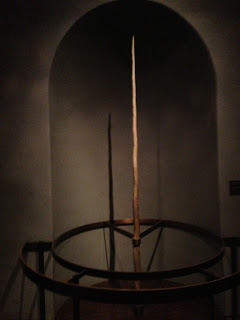
Most of the items were the sort of splendid, jewel-encrusted pieces you'd expect, but some, including the reliquaries, were more unusual. I particularly liked this box, which they dated to 1660 and attributed to Daniel Neuberger.
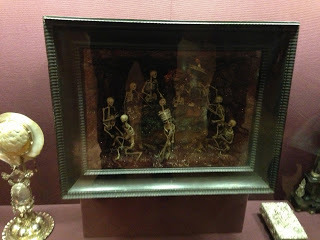
Yeah, I'd like to party with Dan.
Here's a coronation mantle.

Not impressive, you say? It's from 1131.
Sure, this crown is on the rough side.
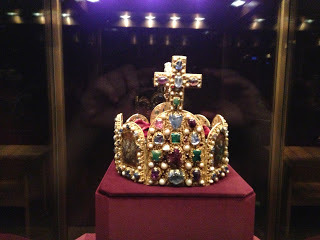
Of course, it's from 1030.
Want a fancy binding for your Bible?
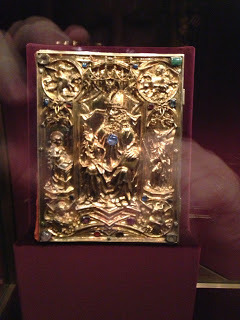
They knew how to do it in 1500.
On the I-said-this-was-a-rough-food-day front, I had to make sure that while I was in Vienna I went to the Hotel Sacher and had an original sacher torte (well, one of the two legally approved originals).

As I'd feared, it was merely okay, even a bit dry. When it comes to quick dessert stops, I'll take a tiny cup of Florentine gelato every day--and it has way fewer calories.
The art today, though, more than made up for the cake.
Published on April 17, 2013 20:59



